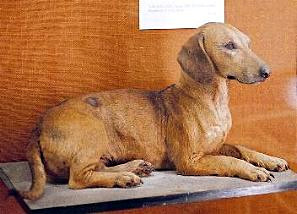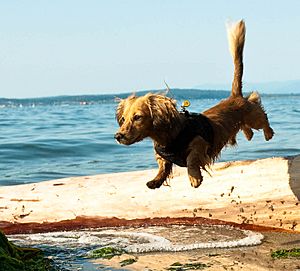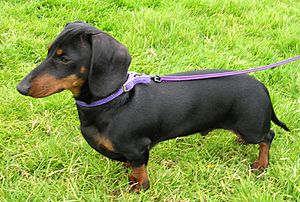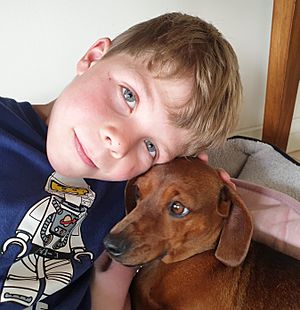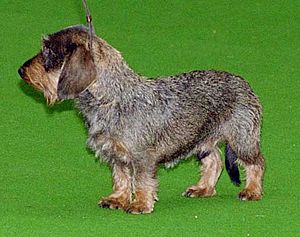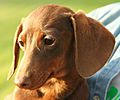Dachshund facts for kids

A red, smooth, standard-sized dachshund
|
|||||||||||||||||||||||
| Common nicknames | Teckel (BNL/FR/GER), Dackel (GER), Doxie (US), Weenie Dog (US/S.Am.), Wiener Dog/Hotdog (CAN/US), Sausage Dog (UK/US/AUS/ZA), Salsichinha (BR), Bassotto (I), Sosis (TR), Perro Salchicha (ES/MX), Worshond (ZA), Taksis (LV), Jamnik (PL), Badger Dog (literal translation), Tax (SE), Такса (Taksa) (UA/RU/BY) | ||||||||||||||||||||||
|---|---|---|---|---|---|---|---|---|---|---|---|---|---|---|---|---|---|---|---|---|---|---|---|
| Origin | Germany | ||||||||||||||||||||||
|
|||||||||||||||||||||||
|
|||||||||||||||||||||||
| Domestic dog (Canis lupus familiaris) | |||||||||||||||||||||||
The dachshund is a special dog breed. It is known for being short in height but long from front to back. It also has short legs. The word “Dachshund” comes from Germany. It means “badger dog.” In Germany, these dogs are also called Dackel or Teckel.
This breed was first developed to use its strong sense of smell. They would find, chase, and hunt badgers. They also hunted other animals that live in holes. Because of its long, narrow body, the dachshund is sometimes called a wiener dog, hot dog, or sausage dog. Some people feel that these nicknames are not respectful to the breed.
Contents
History of the Dachshund
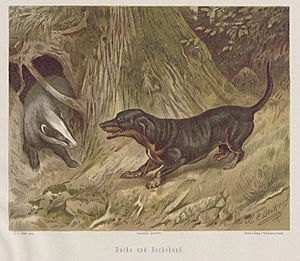
Some experts think that dachshunds might have ancient roots. Drawings from ancient Egypt show short-legged hunting dogs. Recently, mummified dogs that look like dachshunds were found in Egypt. This might support the idea that they are very old.
However, the modern dachshund was created in Germany. It combines features from German, French, and English hounds and terriers. Dachshunds became popular with royal families across Europe. Even Queen Victoria loved this breed.
The first clear mentions of the dachshund appeared in books from the early 1700s. They were first called "Dachs Kriecher" (badger crawler) or "Dachs Krieger" (badger warrior). Before that, "badger dogs" likely referred to any dog used for that purpose. Early German dachshunds were larger than today's standard size. They weighed about 14 to 18 kg (31 to 40 lbs). They came in both straight-legged and crooked-legged types. Modern dachshunds come from the crooked-legged type.
These dogs were famous for hunting badgers. They were also used to hunt rabbits and foxes. They could even find wounded deer. In groups, they hunted large animals like wild boar and fierce ones like the wolverine.
There are different ideas about when dachshunds were specifically bred for badger hunting. Some say it was the 1400s. Others believe it was the 1700s or 1800s.
Dachshunds with a "double-dapple" pattern were brought to the United States around 1879-1885. These dogs can sometimes have eye problems, blindness, or hearing issues.
The floppy ears and curved tail of the dachshund were bred on purpose. Their ears hang down to stop dirt and seeds from getting into their ear canal. Their curved tail helps them be seen in tall grass. It also helps hunters pull them out if they get stuck in a burrow.
The smooth-haired dachshund is the oldest type. It might be a mix of the German Shorthaired Pointer, a Pinscher, and a Bracke (a type of bloodhound). Or it could be from crossing a short Bruno Jura Hound with a pinscher. The exact origins are not fully known.
What we do know is that the short-haired dachshund led to the long-haired and wire-haired types. One idea is that smooth dachshunds sometimes had puppies with slightly longer hair. By breeding these puppies, long-haired dachshunds were created. Another idea is that long-haired dachshunds came from mixing smooth dachshunds with spaniels.
The wire-haired dachshund was the last type to be developed. This happened in the late 1800s. They might be a mix of smooth dachshunds and other dogs with rough coats. These could include terriers or wire-haired pinschers like the Schnauzer or Scottish Terrier.
Appearance (looks)
Today, dachshunds have crooked legs and loose skin. They also have a barrel-like chest. Breeders chose dogs with these features over time. This helped dachshunds burrow better into small spaces. They also have a long tail.
A dachshund's fur comes in three main kinds:
- Smooth or short-haired
- Long-haired
- Wire-haired
The wire-haired dachshund is usually shorter from front to back than the other two types.
Size
A fully-grown standard dachshund weighs between 7 and 12.7 kg (16 and 28 lbs). A miniature dachshund weighs less than 5 kg (11 lbs). The writer H. L. Mencken once joked that “A dachshund is a half-dog high and a dog-and-a-half long.”
Coat and color
Dachshund fur comes in many different colors. The most common colors are red (a reddish-brown) and black-and-tan. Black-and-tan means a black body with brown markings. You can also find solid black and solid chocolate-brown dachshunds. These solid colors are often seen as handsome. However, they are not always "standard" for some dog shows.
Eye color
Light-colored dachshunds can have amber, light brown, or green eyes. But dog clubs usually prefer darker eye colors. Dachshunds can also have two different colored eyes. This is mostly seen in dapple and double dapple dachshunds. For example, they might have one blue eye and one brown eye. This is called "wall" coloring. It is usually not preferred by dog clubs. Dappled eyes, which have spots of different colors, are also possible.
Temperament (mood or emotions)
Dachshunds are playful and fun dogs. They are known for chasing small animals and birds. They do this very intensely and without fear. Many dachshunds can be strong-headed or stubborn. This means they can be a bit hard to train. However, if they are trained properly and from a young age, they can be great family dogs. It's important to train them to be social and to obey commands.
Dachshunds are often very loyal to their owners. They can be much more devoted than some other dog breeds. But wire-haired dachshunds sometimes show less of this strong loyalty. People often notice that dachshunds have deep, expressive eyes. They can communicate a lot just with the look on their faces.
Diet
Dachshunds are a small dog breed. An adult dachshund usually needs about 3/4 of a cup of food per day. You can also feed them 1/2 a cup twice a day.
They can gain weight very quickly if they eat too much. So, make sure they don't get too many treats or table scraps. It's best to have set meal times instead of letting them eat all day.
Health
Dachshunds often have problems with their backbone. This is because their spinal column is very long and their rib cage is short. These problems are usually hereditary, meaning they are passed down from their parents.
A dachshund that is obese (too fat) has a higher risk of injury. The extra weight puts more strain on their backbone. To help prevent injuries, dachshunds should avoid climbing stairs or jumping a lot. It's also important to hold them correctly. Always support both their front and rear parts of the body.
Symbol of Germany
Dachshunds have traditionally been seen as a symbol of Germany. During World War I, political drawings often used the dachshund to make fun of Germany. Because of this, the dachshund's popularity in the United States dropped a lot. People even started calling them "liberty hounds." The same thing happened with "liberty cabbage" for sauerkraut. The connection to Germany caused less of a problem during World War II, and it didn't last as long. Famous Germans like Kaiser Wilhelm II and General Erwin Rommel owned dachshunds.
Because of their link to Germany and their popularity in Munich, a dachshund was chosen as the first official mascot for the 1972 Summer Olympics in Munich. His name was Waldi.
Notable Dogs and Owners
- John F. Kennedy bought a dachshund puppy named Dunker in 1937. He had to leave it in Germany because of allergies.
- Grover Cleveland, a U.S. President, had a dachshund in the White House.
- William Randolph Hearst loved dachshunds. When his dog Helena died, he wrote about her in his newspaper column.
- Fred, E. B. White's dachshund, appeared in many of his famous writings.
- Lump, the pet of artist Pablo Picasso, is thought to have inspired some of his art. The book Picasso & Lump tells their story.
- Andy Warhol had two dachshunds, Archie and Amos. He painted them and wrote about them in his diaries.
- Stanley and Boodgie, owned by artist David Hockney, were painted by him. Their story is in the book David Hockney's Dog Days.
- Wadl and Hexl were Kaiser Wilhelm II's fierce dachshunds. They once caused a small international problem by hunting a valuable bird. Another of his dogs, Senta, is buried at his home in the Netherlands.
- In Zelenogorsk, Russia, a dachshund parade happens every July 25. It celebrates the city's founding and a dachshund monument.
- Joe was the dachshund of General Claire Lee Chennault. He became the mascot for the Flying Tigers during World War II.
- Maxie, owned by actress Marie Prevost, tried to wake his dead owner. His barking brought neighbors to the scene. This event inspired a song by Nick Lowe.
- Liliane Kaufmann, who commissioned the famous house Fallingwater, bred long-haired dachshunds. A book called Moxie is about one of her dachshunds who lived at Fallingwater.
- The former Queen of Denmark, Margrethe II, loves dachshunds. She has owned many throughout her life. For her 80th birthday in 2020, she posed with one of her favorite dachshunds, Lilia.
- Obie was a dachshund famous for being very obese. He weighed 77 lbs (35 kg), more than twice a normal dachshund. He reached his healthy weight of 28 lbs (12.7 kg) in 2013.
- Carole Lombard and Clark Gable had a dachshund named Commissioner.
- Crusoe the Celebrity Dachshund became famous on social media. He wrote two The New York Times best-selling books: Crusoe: Adventures of the Wiener Dog Extraordinaire! (2015) and Crusoe: The Worldly Weiner Dog (2018). He won the "best animal" award at the Shorty Awards and the People's Choice Awards Animal Star of 2018.
Images for kids
See also
 In Spanish: Dachshund para niños
In Spanish: Dachshund para niños


